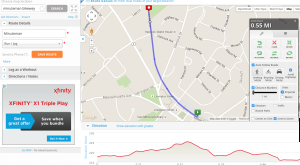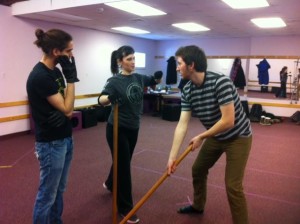This weekend was awesome! Amongst enjoying a lovely evening at Waterfire in Providence, a great night at a sweet Victorian B&B, an evening of Shakespeare on Boston Common, and some wonderful food to boot (best meal I’ve ever had at Gracie’s), we also ran Wipeout, Boston! It was a great time, and a full race recap is planned for later this week when photos have been released, but for now I’d like to talk about something I observed on the course: bad race etiquette.
There is definitely an unspoken code of conduct for runners, particularly when out on a packed course. Because this was a fun run rather than hypercompetitive (there was no chip timing, no division prizes, and no ranking system), there were a lot of novice runners out there. It was really great to see people who might not otherwise have tried a run going out on a limb with this one. I will never complain about beginners having a go at running! But for the sake of everyone’s good time, I’m going to take a moment to state a few good rules of thumb to follow on race day.
Obey Traffic Laws
It’s not a problem that some folks run slower than others; as I’ve said I’m a back-of-packer myself. Everyone should take a course at their own pace; particularly when the weather is as nasty as it was on Saturday (it was upwards of 85 degrees at times…. Yikes!). But if you are going to slow down, or if you need a walk break, make sure you’re pulling over to the right to let faster runners get past. This is also important if you’re doing the course with a large group; by all means hang out with your friends, but make sure that you’re clustering to one side so that you’re not “taking over” the road. Pay particular attention to this when the course narrows and there’s less space in general; make sure you’re leaving room for others to pass you.
If you do hear someone say something like “on your left”, that’s a polite way of being told to please squish over. Don’t be upset about it, just let the faster runner by as best (and expediently) as you can.
Guests aren’t Runners
If you have a cheering squad, that’s awesome! But it’s important that only runners with bibs are on the course at any given time. While your family and friends might be tempted to walk with you for a short section, or hop on the course to take a picture with you at an important mile-marker, please remind them that the course only has limited space and other runners also need to use it. If you’d like to greet your family, duck over to the side and step off for a moment.
If there are snacks at the finish line, please remind your family that those snacks are for the

Always pull right before taking runselfies. Because you just don’t want to be “that guy”
runners. Bring other non-runner snacks, or go out for food together after you triumph. Often, these snacks are donated to the race and are finite in quantity. When they’re gone, they’re gone. What this means is that if the runners and their guests at the front of the pack finish all the snacks, the back-of-packers don’t get a chance to replenish themselves at the finish line. If you’re cheering squad REALLY wants to be part of your race experience, convince them to run with you! Then they also get all of the perks of being a runner, and you can take selfies together as you go.
Don’t Block the Aid Station
When you finally hit that water station, you’re definitely yenning for some hydration! But so are the runners behind you. Rather than walk up to the table and monopolize the space, grab your cup from the volunteers, and continue on your way. If you do need to stop at an aid station for any reason, make sure you clear the table and tuck to the side before stopping. Standing directly in front of the table is disruptive to the flow of the race, and might keep others from getting their much-needed hydration.
Clean up
If you, for any reason, need to “get rid” of something: trash, extra clothing, etc., find a way to keep the article on your person rather than dropping it on the course. Tuck empty gu packets in pockets, pouches, or waistbands. Tie unneeded sweats around your waist and keep running. Detritus on the course can create a huge trip hazard for other runners as well as a headache for race officials since these items now become their cleanup responsibility. Respect the volunteers, officials, and other runners and be self-sufficient out on the course. The world will thank you for it.
Finish Strong and Move On
Yay, you’re at the finish line, you did it! But don’t come to a dead stop once the race photographer grabs your victory pic. Continue moving away from the finish chute and clear the finish area before you find a place to stop. This is an important step towards keeping crowds managed at the finish line, and making sure that all the runners get their triumphant victory finish without delay or interruption.
While some of these may sound like generally logical ways to behave in the circumstances, you’d be surprised at the things people do when they’re tired, adrenaline hyped, a bit dehydrated, and simply not thinking straight. Don’t be that guy. Nobody likes that guy.
Happy Running!








